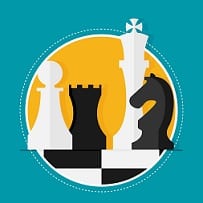
Chess Strategy : 4. Superior Minor Pieces (p90)

- Minor Pieces are the Knights and Bishops.
- Some say that a Bishop is worth 3½ points versus 3 points for a Knight. However, the majority of players value Knights and Bishops as being worth 3 points each.
- Valuing material is most often used when it comes to Exchanges and for totting up who holds an Advantage, using the Point Count system.
- Although the Point Count system is a useful tool, for keeping tabs on your progress, don’t allow it to blind you from what’s actually happening on the board, in any given situation.
- It’s vital you know the conditions that make your Minor Pieces more or less valuable.
- Closed Positions – when Pawns are locked in the middle of the board – are best played with Knights …Should it come to trading Pieces, in this situation, you’re able to lose one or both of your Bishops – just keep hold of your Knights!And if you’ve lost your Bishops, but still have one or both Knights, then you must play to get the middle of the board locked with Pawns.
- Open Positions suit the long-range abilities of the Bishops …Naturally, it’s the opposite of Closed Positions … When the board is Open and trading is on offer, your Knights are of less value, so can be exchanged. But, keep hold of your Bishops!.If you lose one of your Bishops, you must play for an Open Position, else that remaining Bishop could become redundant, trapped in your own territory.
Bishops Over Knights (p90-96)
- Knights become far less effective – and inferior to Bishops – if they cannot get to their preferred, advanced squares: Ranks 5 & 6.[ For more, regarding the Knight’s positioning, jump to Section 3 ]
- Structure your Pawns and spare Pieces so they control the Knight’s advanced landing squares – both before the Knight arrives and once it’s settled there.(Note: a Pawn/Piece doesn’t control the square it’s on, only the squares it can target from its current location).
- If you need to fight an enemy Knight with a Bishop, make sure the conditions resemble an Open Position, prior to your attack(s) …Remember: Bishops need their diagonals clear, so they can efficiently attack and evade capture, as needed.
- In the Endgame, where there is plenty of Open space, a Bishop will be superior to a Knight – especially when it comes to capturing enemy Pawns that threaten Promotion.
Seirawan Strategy Example (p91)
Diagram 55: Black to play
Diagram 56 (below): White to play
Seirawan Strategy Example (p92)
Diagram 57: White to play
Game: Petrosian-Lilienthal, Moscow, 1949
Seirawan Strategy Example (p94)
Diagram 58: Black to play
Seirawan Strategy Example (p94)
Diagram 59: White to play
Game: Kalantar-Petrosian, Erevan, 1948
The Dominating Knight (p96-101)
- Bishops become far less effective – and inferior to Knights – when Pawns become locked in the middle of the board.
- As the Bishop cannot jump, it’s stuck on whichever side it’s on, when the position Closes. But the Knights haven’t a problem, as they CAN jump over the obstacles, causing havoc on both sides of the divide.
- Whether the board features an Open or Closed Position, a Knight will become significantly stronger if it can sit at the head of a Support Point – usually created out of a Chain of Pawns.
Seirawan Strategy Example (p96)
Diagram 60: White to play
Game: Karpov-Seirawan, Mar del Plata, 1982
Seirawan Strategy Example (p98)
Includes Diagram 61: Black to play
Game: Seirawan-Vukic, Nis, 1979
Color Control (p101-107)
- It will be much easier to fight your enemy with one Knight IF you take away at least ONE of his Bishops …
A Bishop’s single-color limitation is revealed when it’s unable to work with its other Bishop, on the opposite color … Your Knight will have more success against a single enemy Bishop.
Seirawan Strategy Example (p16)
Diagram 62: White to play
Game: Damjanovic-Fischer, Buenos Aires, 1970
Seirawan Strategy Example (p104)
Diagram 63: Black to play
Game: Botvinnik-Bronstein, World Championship Match, 1951
Seirawan Strategy Example (p104)
Includes Diagram 64: White to play
Game: Seirawan-Short, London, 1982












